Batten down the hatches
The UK boasts a unique and stunning landscape defined in part by its shifting seasons and changing weather. But below this beauty lies a savage nature which can sometimes hit with little or no warning.
The result can be devastating: Arctic-like winters, unimaginable floods, hurricane-force winds, baking heat and severe droughts. Like it or not, Britain can be susceptible to some deadly weather events – even if they only occur once in a while.
1947
The big snow
With record amounts of snow, one of the cruellest winters in living memory couldn't have come at a worse time for war weary Britain.
Victorious but nearly bankrupt from defeating the Nazis, the country was still experiencing food rationing when 10ft snow drifts paralysed the country. Roads and railways were blocked, miners couldn’t get to work and London had only six days' worth of coal left. Meanwhile, in the countryside the snow was so deep that farmers couldn't reach their livestock and animals starved to death in frozen fields across Britain.
1947: Emanuel Shinwell, Minister for Power, warns that Britain faces complete disaster. Nationwide (BBC One, 1973).
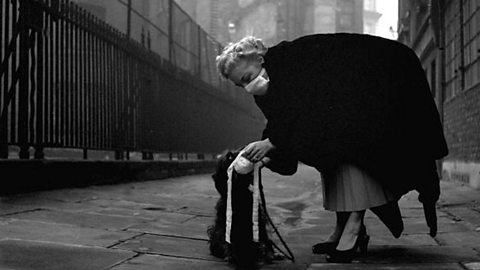
1952
London's great smog
Smog in 1950s London was common, but the toxic mix of smoke and fog that descended on 5 December 1952 was unlike anything the city had seen before.
Domestic coal was low-grade and thousands of tons of stinking soot were being pumped into the city's skies daily. High pressure caused a temperature inversion, where the air is warmer aloft than at the surface, preventing the smoke from escaping upwards. With little wind to disperse the polluted air, the killer smog remained for five long days, leading to the premature deaths of over 4,000 people. As a result the government introduced the Clean Air Act in Britain.

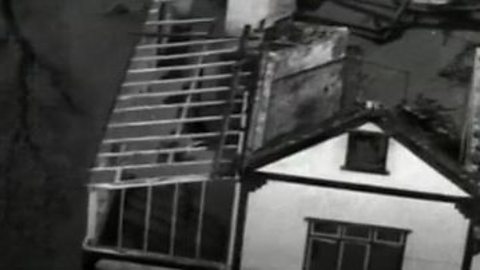
1953
Storm of the century
The great storm of 1953 was Britain's worst peacetime disaster on record claiming the lives of 307 people.
With no severe flood warnings in place and phone lines down, people were completely unaware of the devastation which was about to hit them. The storm surge – a combination of gale-force winds, low pressure and high tides – brought havoc to over 1,000 miles of coastline and 32,000 people were displaced because of flooding. The event led to an official service for the forecast of coastal flooding and eventually the creation of the Thames Barrier.

1963
The big freeze
The coldest winter in living memory seemed relentless, lasting for three long months. It was so cold that rivers, lakes and even the sea froze over.
On 25 February 1963 a record low of -21C was recorded and BBC News reported: "By the time this blizzard had finally blown itself out, 200 main roads were impassable and 95,000 miles of road were snowbound."
Weatherman Paul Hudson looks back to the winter of 1962-63. Wild Weather North West (BBC One, 2012)
1976
When Britain was left bone dry
It was the warmest three months in living memory with milk blue skies and sunshine that seemed to never end.
It should have been the perfect summer, but with the continued sunshine came the worst drought in 150 years. Rivers dried up, soil began to crack and water supplies were on the verge of running out in Britain’s most dramatic heatwave of the 20th Century. The drought was so rare, Britain appointed its first ever minister for drought, Denis Howell. He was nicknamed the minister for rain as the day after they installed him the heavens opened for the next two months!
Archive clip featuring BBC weatherman Jack Scott reporting on the heatwave in the summer of 1976. Hurricanes & Heatwaves (BBC Four, 2013).
1979
Fastnet race of death
The greatest disaster in the history of modern sailing resulted in one of the biggest air and sea rescue operations in peacetime Britain.
The deadly storm claimed the lives of 15 people. The race from Cowes to the Fastnet Rock and then to Plymouth via the Scillies started in fine weather, but terror awaited those competing. One of them was John Rousmaniere. In his book he describes the event: "On day two a force 10, 60-knot storm swept across the north Atlantic with a speed that confounded forecasters, scattering yachts in the treacherous waters. For 20 hours, 2,500 men and women were smashed by 40-foot breaking waves."
Matthew Sheahan's harrowing account of the 1979 Fastnet yacht race. Wild Weather (BBC Two, 2002). Please note that this video contains an account of a storm that some children might find distressing.
1987
Britain's first sting jet
The storm of 1987 left an indelible mark on our national conscience. Weatherman Michael Fish, like other forecasters, didn't see it coming.
Douglas Hurd, the Home Secretary at the time, referred to it as "the worst night since the Blitz". Eighteen people died and over 15 million trees were lost when hurricane-force winds blasted through south-east England. Meteorological research revealed a completely new weather phenomenon called the sting jet. This powerful 100mph wind can literally smash anything in its path. It was the first ‘sting jet’ to be documented in Britain.
Despite warnings on French news BBC weatherman, Michael Fish, failed to warn Britain of a devastating storm on the 15 October 1987.
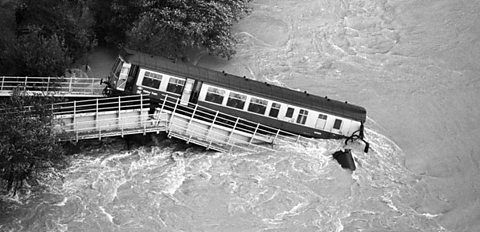
1990
Burns Day storm
Tragedy has walked hand in hand with the storms of Britain and the one that raged on 25 January 1990 was no exception.
The storm proved even more deadly than the one in 1987 because it hit during the day. It caused chaos – killing some children in their schools when the roof collapsed, and throwing cars off the road. Forty-seven people lost their lives and at least half a million homes were without electricity. The total estimated damage was over £2bn. Unlike 1987, the Met Office had predicted the storm’s progress and had issued warnings.

2003
Hottest day in history (then)
In August 2003 a new UK record was set when temperatures reached 38.5C (101.3F) in Faversham, Kent.
By the end of the summer of 2003 the heat had claimed the lives of over 2,000 people in Britain, mostly through heat stroke or dehydration. Since then the government Heat-Health Watch system warns if the forecast for daytime temperatures is 30C or above and 15C at night.
Kate Humble on the human cost of deadly heatwaves. Climate Change: Britain Under Threat (BBC One, 2007).
2004
Boscastle: A village upended
Few parts of Britain have escaped serious flooding, but what happened to Boscastle in 2004 truly shocked the UK.
August in Cornwall is one of its busiest holiday periods, but this was when unimaginable flash flooding completely submerged this picturesque Cornish village. Around 100 people had to be plucked to safety by emergency teams; some on rooftops which they had climbed to escape the rising waters when the river burst its banks. Close to 150 cars were swept out to sea and over 50 properties were either flooded or completely destroyed. Miraculously no one died.
Residents are airlifted to safety in heartbreaking scenes of an entire village submerged by flooding. Duncan Kennedy reports for BBC News.
2022
A new hottest day ever
On 19 July 2022 the temperature in England hit 40 degrees Celsius (104.5 Fahrenheit) for the first time ever. These pages include BBC Weather reporting on a red weather warning for heat on 17 July 2022 and CBBC Newsround reporting on widespread drought, including at the source of the River Thames. In both cases scroll down the page to locate the video content.
BBC weather forecast 17 July 2022. collection
July 2022: BBC Weather predicts record temperatures in the coming days
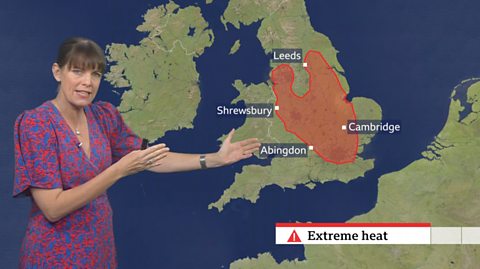
CBBC Newsround: 2022 - the joint hottest year. collection
CBBC Newsround reports on widespread drought, including at the source of the River Thames
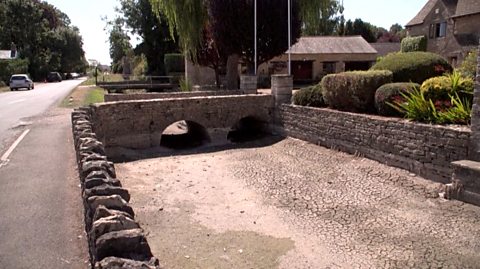
2024
Storm Bert brings havoc
In late November 2024 Storm Bert caused widespread flooding in the UK. It was a particularly bad storm, though just one of the increasing number of storms to hit the UK in recent years. These pages include videos explaining why warming temperatures leads to increasingly heavy rainfall and arial views of the devastation caused by Storm Bert across the country.
Storm Bert - News report. collection
Storm Bert: How climate change causes wetter winters
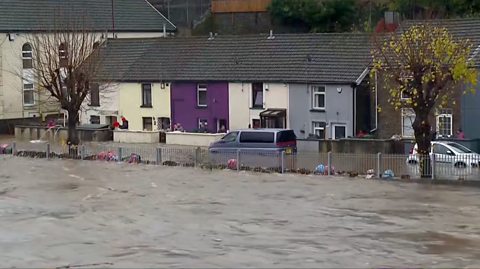
Storm Bert - arial view. video
From above: arial views of the widespread flooding caused by Storm Bert
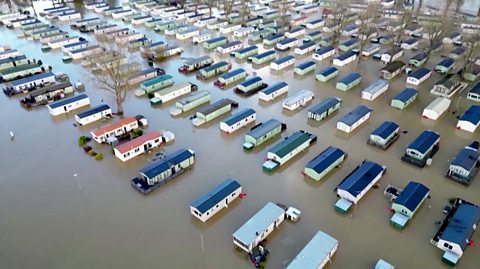
Learn more about this topic:
British plants, animals and landscapes through the four seasons. video
A look at the array of behaviour shown by plants and animals throughout the year, in tune with the seasons and the seasonal weather.

Geography: The Big Issues. collection
A series of short films in which students investigate 'big issues' in geography such as fracking, coastal erosion and intensive farming.
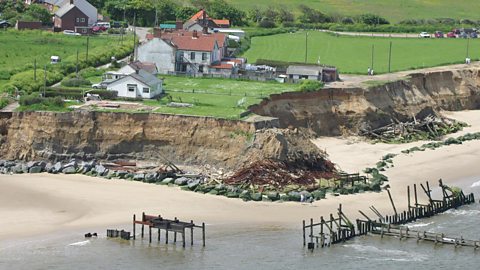
Richard Hammond's Wild Weather. collection
In this series of short films, Richard Hammond explores different types of weather and the different principles behind each of them.
